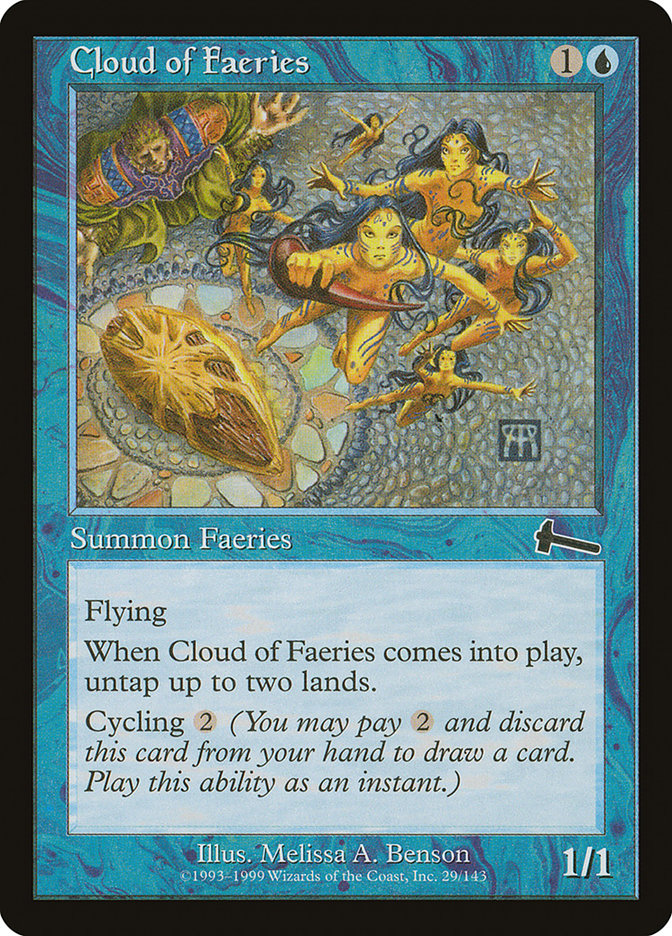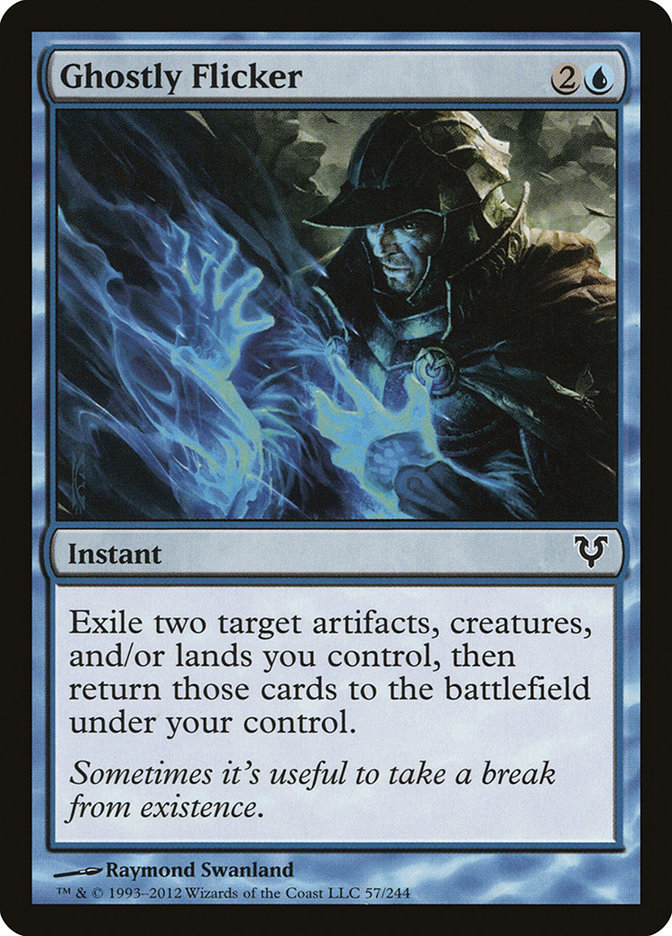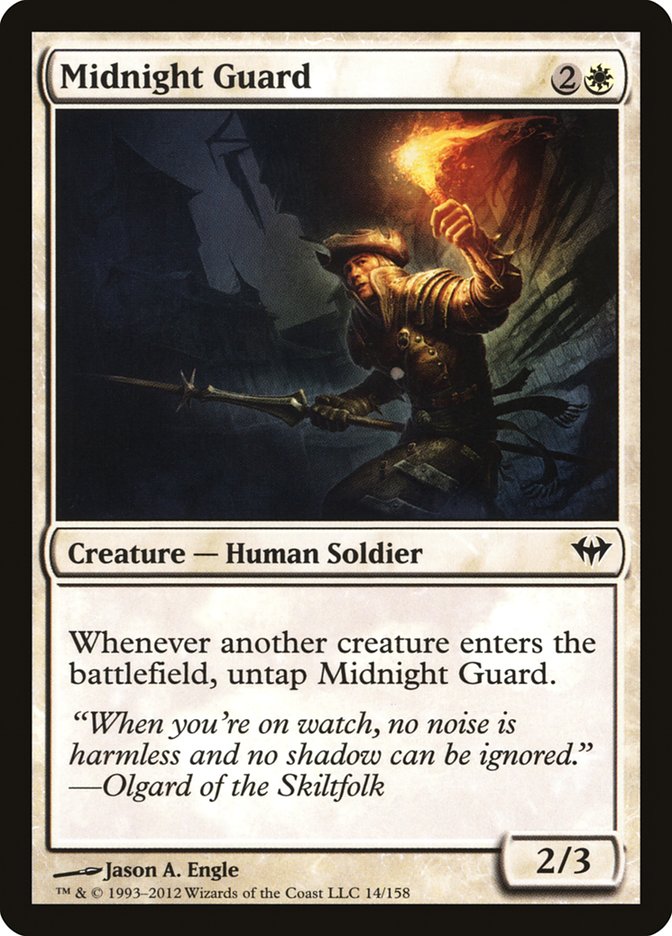Stand up, arms out, stretch and flex my fingers, sit back down.
I’m back! After a break inspired by “holy heck I’m moving and there are so many boxes oh wait I don’t have internet yet,” I have returned to talk about all the common things.
While I’m thrilled that Magic Online will (reportedly) be getting Daily Events back in a week (from publication of this piece), that still leaves one row of the calendar to the single-elimination eight-person queues. These tournaments reward a different style of play than the four-round Swiss Daily Events. In a Daily, one loss matters far less since a prize is still a possibility. Not so in the single-elimination realm. Daily Events reward consistent decks that can handle a wide variety of matchups, whereas the eight-person queues reward decks that can flat-out ignore the opposition and steamroll their way to victory. Recent trends in the released results (paltry as they may be) have shown an uptick in the prevalence of combo decks.
This makes sense—the combo decks in Pauper do not care about what the opponent is doing a vast majority of the time. They simply seek to assemble the machine and win. Unlike Modern, Pauper has access stitchers like Ponder and Preordain to help these decks increase their consistency. Even though storm has been whittled out of the format as a win condition (until someone wins with their Thousand-Hand Slap Astral Steel deck), the archetype is far from dead. Let’s start at the top, shall we?
Creatures (21)
- 4 Cloud of Faeries
- 4 Sunscape Familiar
- 3 Nightscape Familiar
- 4 Mulldrifter
- 2 Mnemonic Wall
- 3 Sea Gate Oracle
- 1 Sage's Row Denizen
Lands (21)
Spells (18)
Sideboard

The inheritor of the Temporal Fissure combo decks, this beast goes by many names: Fissureless Fissure or Familiar Combo are known aliases. Regardless of what you silently curse under your breath when matched up against it, this is probably the best combo deck in Pauper.
Esper Sage wins by assembling the Rube Goldberg contraption of Cloud of Faeries, Azorius Chancery or Dimir Aqueduct, two copies of Sunscape or Nightscape Familiar, Mnemonic Wall, Ghostly Flicker, and Sage’s Row Denizen. The first three items listed are key to the engine of this contraption. With the Familiars in play, Cloud of Faeries costs a meager U and can generate seven mana (tap both lands, spend one, untap, and retap), which when you get right down to it is an absurd amount of mana for a single card.
This mana is then used to draw cards by running Mnemonic Wall and Mulldrifter through a Ghostly Flicker or to generate even more mana with Ghostly Flicker, Cloud of Faeries, and Mnemonic Wall. Once this final cog falls into place, it is only a matter of time before the deck finds a copy of Sage’s Row Denizen and starts milling four cards per repetition. It does not take long for the deck to reduce a library to zero, and it can even Compulsive Research to win on the spot instead of waiting for the next draw step.
Unmolested, this deck can routinely go off on turn 4 and has little trouble winning the game on turn 5. Many of its pieces are also excellent blockers—Sunscape Familiar and Sea Gate Oracle—and can halt a beatdown deck just long enough to put all the gears into place. If those aren’t enough, the deck can bring in Lone Missionary to send through the Ghostly Flicker slip ‘n slide to boost a life total to nigh impenetrable levels. The deck also has the ability to go beatdown and win through Mulldrifters in the air. All the mana from step one of the combo is just as good at casting flying fish as it is as doing unfair things.
Esper Sage is resilient. Not only does it have the dual path to victory, but it can also start and restart its combo as needed. This means that on the normal “I win” turn it can go through all the motions, not win, and still be in good enough shape to go through the motions and win the next turn. This cannot be understated since so many of the cards available to fight the combo in Pauper are one-shot deals. The best way to combat this combo is to attack the graveyard with cards like Bojuka Bog, Nihil Spellbomb, and Relic of Progenitus to take out the Ghostly Flicker with Mnemonic Wall’s ability on the stack. This is all fine and dandy until Esper Sage finds the second Ghostly Flicker of course.
There are some serious downsides to this deck at the moment. First, it is incredibly click intensive. While I have not piloted the deck, I have had my face pummeled by it a few times in tournaments. I always force my opponents to actually win instead of scooping up my virtual cards. The combo takes quite a bit of time, and someone who is not practiced with the deck could lose to the clock.
The first few turns are an incredibly vulnerable time. Running Evolving Wilds and Azorius Chancery, Esper Sage often ends turns completely tapped out until it goes off. Being able to take out a Chancery (or Dimir Aqueduct) while also applying pressure can go a long way to knocking the legs out from the combo player. This might not be the most exploitable hole as failure to execute on the early advantage means that Esper Sage can recover and win, but it is still important to note that this deck takes a few turns to get its pieces in place.
Esper Sage also relies on creatures to win. Mono-Black Control is a popular deck that can take out a Mnemonic Wall or Sage’s Row Denizen for good. Timing a Doom Blade just right (and working around Snap), MBC can leave Esper Sage in dire straits.
All that being said, if I were looking to grind the eight-person queues for the final week, there are worse options than Esper Sage Combo. The deck is resilient and plays one of the more bonkers mana engines in the format in Cloud of Faeries. And hey, who doesn’t like alternate win conditions?
Creatures (24)
Lands (22)
Spells (14)

This is a deck that made a splash in the first week after the Temporal Fissure and Cloudpost banning, and it has made its presence felt again. This hybrid deck plays on the first level like a Selesnya-theme deck: make lots of tokens, gain lots of life, and overrun opponents by sacrificing Saprolings to Pallid Mycoderm. Ho hum, another day at the Conclave.
The magic happens when Midnight Guard gets enchanted with Presence of Gond. This allows the Dark Ascension filler to generate an [arbitrarily large] number of tokens. Combined with Soul Warden, Essence Warden, and Soul’s Attendant, that is an even [arbitrarily larger] amount of life. This can all be done during the end step, which means death by Elf tokens (it should be noted that these cannot be pumped by Pallid Mycoderm).
Midnight Gond’s strength resides in its dual nature. Being able to present more threats, even at the barely substantial stats of 1/1, than an opponent can answer is a good way to win a game of Magic. Cards like Spidersilk Armor (or Veteran Armorer in) can brick an opposing Electrickery. Crypt Rats could easily wipe out a fungal army, but then the cycle can just start again next turn. Much like Esper Sage, Midnight Gond can rebuild with a lone Sprout Swarm (even if it is a bit mouse heavy). The infinite combo aspect of the deck just does more of the same but allows the deck to simply go over and beyond any potential removal.
Where Esper Sage can be hindered by a well-timed removal spell, Midnight Gond is quite fragile in the face of cards like Victim of Night. Blowing up a Midnight Guard in response to Presence of Gond is one of the ultimate feel-bad moments, and the same cards that handle this also put a hurt on Pallid Mycoderm. Mono-Black Control rears its head again as the enemy of combo since not only does it have removal but it can also go around an army of blockers with Gray Merchant of Asphodel and Corrupt. Crypt Rats clears the out the Soul Warden triplets so that the game-ending spells from the Swamps deck can actually get the job done. Also, just like Esper Sage (and a recurring theme in the combo decks), Midnight Gond requires a lot of work with the digital rodent, so without practice this deck could beat itself.
How about something completely different?
Creatures (28)
- 4 Elves of Deep Shadow
- 4 Tinder Wall
- 1 Crypt Rats
- 1 Anarchist
- 4 Wild Cantor
- 4 Simian Spirit Guide
- 4 Street Wraith
- 2 Manaforge Cinder
- 4 Balustrade Spy
Lands (1)
- 1 Forest
Spells (31)
- 4 Cabal Ritual
- 4 Dark Ritual
- 4 Land Grant
- 4 Conjurer's Bauble
- 4 Songs of the Damned
- 1 Haunting Misery
- 2 Morgue Theft
- 4 Lotus Petal
- 4 Destroy the Evidence
Sideboard

Well, that’s unexpected.
Developed by Shaffawaffa5 and tuned by ObZen, this deck is Pauper’s answer to Legacy oddity “Oops, All Spells!” This deck endeavors to flip every last card in its library into the graveyard through Balustrade Spy. Then the deck has a few routes to victory:
1) Generate enough mana with Songs of the Damned to retrieve Anarchist and Simian Spirit Guide with Morgue Theft, cast Anarchist targeting Haunting Misery, and then cast Haunting Misery for the win.
2) Have a Conjurer’s Bauble in hand during the Balustrade Spy turn and use it targeting Haunting Misery with an empty library. Generate enough mana with Songs of the Damned to cast Haunting Misery.
Seems simple enough.
This combo deck does not have a tournament pedigree like the others. It is an admitted novelty, but it still has some level of merit. One-Land Combo just wants to do its own thing and can do it quite well. It has a natural resilience to Esper Sage (provided they don’t try to end the game with Compulsive Research) and has the ability for a turn 1 kill with a hand of three mana sources, Dark Ritual, Songs of the Damned, and Balustrade Spy. Winning before an opponent’s draw step is more than just a dream with this stack.
There are multiple problems with One-Land Combo. It is incredibly vulnerable to graveyard hate while also suffering at the hands of life gain and countermagic. A single counter on Haunting Misery is game over. Life gain is also a death knell since the deck has an upper limit of 25 damage. So yeah, that double Lone Missionary draw never looked so good.
Wrapping up, I want to set your mind free.
Creatures (10)
Lands (3)
Spells (47)
- 9 Forest
- 4 Island
- 1 Capsize
- 4 Fertile Ground
- 1 Kaervek's Torch
- 4 Freed from the Real
- 1 Gigadrowse
- 3 Train of Thought
- 4 Utopia Sprawl
- 4 Ponder
- 4 Preordain
- 4 Forbidden Alchemy
- 4 Abundant Growth
Sideboard

Freed from the Real represents the first successful Pauper combo deck. Back in the days of Player Run Events, the deck won by animating a land that could produce more than one mana with Lifespark Spellbomb and then enchanting that land with Freed from the Real to generate enough mana to draw the deck with Train of Thought and win with either Kaervek’s Torch or Pyromatics.
I said it was first; I never said it was elegant.
With the rise of Storm Combo, the need for Freed from the Real declined, and eventually the deck vanished almost entirely. Of course, that changed recently in the rounds of another Player Run Event. In the wake of suspended Daily Events, Casting Commons hosted a tournament on November 23rd. After five rounds, the event cut to Top 8, and Freed made it in the seven spot. In the quarters and semis, it squared off against both copies of Esper Sage and came out ahead, falling only to Delver in the finals.
How is this deck different? First, it has stripped away the Lifespark Spellbomb element and instead focuses on Arbor Elf and Voyaging Satyr. The goal is to load up a Forest with Utopia Sprawls and Fertile Grounds to enable mana generation with Freed from the Real. Then the deck can either draw itself with Train of Thought or use Forbidden Alchemy to dig for the win condition in Kaervek’s Torch. Just like the other pure combo decks in this article, Freed can go about its business while pretending to play solitaire. Once the device is online, it is nearly impossible to stop since the mana can be generated at instant speed—just make sure there’s enough for both Train of Thought and Kaervek’s Torch.
Johnny’s dream also has an interesting blocking technique. Using its mana engine, Freed combo can tap down any opposing permanent with Gigadrowse (and many replicated copies). This will leave the coast clear for all sorts of shenanigans and works wonders (unless your adversary is packing Snapback).
Freed combo is as vulnerable as it is venerable. Unlike Esper Sage, it lacks Snap or Ghostly Flicker to protect its key creatures, and are they ever fragile. Arbor Elf and Voyaging Satyr die to just about everything, so unless you are expecting nothing but other combo decks it’s probably worth packing some sort of defensive measures; Vines of Vastwood is a strong candidate for this spot. The plus side is that this deck is largely impervious to graveyard hate and does not care how high an opposing life total goes. So all you have to do is figure out a way to keep your creatures alive and then you win.
Simple enough, right?
That is actually the weak spot of all these combo decks. Unlike the original Empty the Warrens and Grapeshot decks that were mono-spells, these decks can be attacked by a common Pauper metric: creature removal. Cloudpost based Temporal Fissure decks could just set up a situation where they could cast every key spell in one turn and do so before removal could be accessed. Now at least those Diabolic Edicts and Lightning Bolts have a puncher’s chance.
Finally, aside from the unproven One-Land Combo deck, these weapons all have an enemy in the clock.
So there you have it—four options to take into single-elimination gauntlets and ignore the happenings on the other side of the internet. Me? Well, I won’t lie—I’m looking forward to the return of Daily Events. But until then, there’s nothing wrong with breaking some faces with combo.
Keep slingin’ commons-
SpikeBoyM on Magic Online
https://www.facebook.com/nerdtothecore
The Colors of Pauper: W U B R G
Discuss Pauper on Twitter using #MTGPauper






